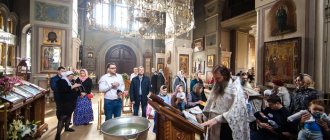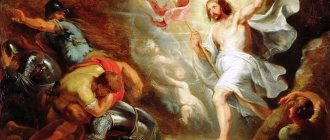LUTHERANS,
a Protestant denomination guided by doctrinal and organizational principles proclaimed by Martin Luther in the 16th century.
Lutheranism is the oldest and largest branch of Protestantism. It traces its origin directly to the initiator of the Protestant Reformation. In the 17th century The name Evangelical Lutheran Church acquired a semi-official character, and its members began to be called simply Lutherans. There are currently more than 70 million Lutherans worldwide, most of whom live in the USA, Canada, Scandinavian countries and Germany. See also
PROTESTANTISM.
Teaching.
Also on topic:
REFORMATION
Lutherans emphasize the continuity of the development of Christianity and are convinced that in the Reformation a new church was not created, but an ancient one was restored. Reforms were undertaken in areas where - in the opinion of the reformers - medieval teachings deviated from the Bible and where religious practices and church institutions contradicted the testimony of Scripture. Luther's followers maintained that in matters of faith each person is answerable only to God, and they replaced the traditional church doctrine of salvation with the doctrine of justification by faith alone. These provisions retained their fundamental significance in the Lutheran confession; they significantly influenced the development of the doctrine and ethics of Lutheranism.
By general definition, justification means that God accepts the sinner as His child and heir of eternal life. Lutherans believe that the entire initiative in this act of reconciling man with God belongs to God. Therefore, in accordance with Lutheran teaching, justification lies in God’s acceptance of the sinner, in his creation of a new relationship between himself and the whole personality of man. Forgiveness of sins and deliverance from eternal punishment for it is not achieved through the performance of church rites; salvation does not depend on a person’s own efforts. Justification is not a reward for keeping the Law, but a gift of God, offered in Christ's sacrifice on the cross and obtained through faith. Man does not even participate in the preparation to receive this grace, since faith in man is created only by choice and by the action of the Holy Spirit.
Like Catholics, Lutherans believe in the existence of the Trinity, the presence of two natures in Christ, the resurrection, the Last Judgment and life after death. Much of the Lutheran doctrine goes back to the Apostolic
,
Nicene
and
Athanasian Creeds
.
See also
SYMBOL OF FAITH.
Lutherans recognize the sacrament of the Eucharist and believe that the Body and Blood of Christ are present in the sacrament. Although the bread and wine are preserved in their form, the communicant receives Christ in the divine and human natures. Lutherans also recognize another sacrament - baptism, which is usually performed in infancy. Both sacraments are seen as means of grace, not as symbols or memories.
Lutheran baptism. How it was. Grandma's look
Hello my near and distant readers!
Today, my story is about church heritage. Agree, it is in the spring, when you want to cleanse yourself both spiritually and physically from winter stagnation, that a feeling of renewal and an expressive desire for gratitude for life comes... You want to believe, to believe in the best, in the optimism of life. I want to close the voids of my heart and soul, be filled with blessed energy, and refresh my thoughts.
Today, my state of spiritual renewal smoothly intersects with the state of spiritual experiences of the past. Therefore, I decided to share with you my observations of the sacrament of baptism for children and my grandchildren. Lutheranism is not my faith, and when my daughter and her husband (the husband is Finnish/Lutheran, the daughter is Russian/Orthodox) approached this topic, I had the opportunity to touch on a new experience.
What surprised me, what pleased me, and what amused me - read, my dears, in this story.
Why are children baptized? Probably... to strengthen the child’s vitality, strengthen his Heavenly protection, strengthen the intuitive connection with his guardian angel.
In Lutheranism they say that double names are given to children to strengthen the guardian angels of the family. I agree with this explanation. What is important about a two-name concept? It is important that the first name comes from the parents, from the family roots, and the second name is a tribute to fashion or other circumstances.
We baptized our grandson at the age of 2 months, before this age, in his medical record and other documents - in the name column - there was a dash. They called him simply - mother’s son so-and-so... Peculiar, isn’t it?
We decided to hold the baptism ceremony in a classical Lutheran church (Vihdin Kirkko) from the 18th century. The pastor - the rector of the church, a week before the celebration - according to tradition, was obliged to visit the family where the baby was born.
For reference:
- In Finland, 76.4% of the country's residents are registered in Evangelical Lutheran parishes. They all pay church tax, which is 1% - 2% of gross salary. Weddings, baptisms, funerals are free for parishioners.
The spiritual conversation within the walls of our house was quite interesting. The pastor mentioned Martin Luther, recalled his reformation, then talked about family values, and that was the end of his introductory part. For the next 3 hours we just “chatted.” The Holy Father turned out to be a real status father, about 70 years old. I drank coffee and refueled with pies and sweets. At the same time, he remained friendly and smiling. He said... that he had a very decent income, his words were confirmed by the latest brand of executive Mercedes in which he drove.
The sacrament of baptism at the altar truly resembled a celebration. The arches of the kirk, its ascetic decoration, the prayer content - all this had its own unique style and form. Our baby was in the arms of his godmother, the rector was reading the Bible, relatives and friends of the parents were on the nafa bench. Parents watched the ceremony, standing at a distance from the font. At the end of the ceremony, we were all given small bibles and we read aloud a couple of excerpts from the prayer text. None of those present made the sign of the cross (crossing oneself with the hand). The apotheosis of christening was the sprinkling of water on the baby’s head. Everything went calmly, calmly, unhurriedly - in the spirit of the Scandinavian mentality.
After baptism, according to custom, relatives and guests gather at the table. All the invitees, the pastor and very distant relatives met in our house. It’s another test... I’ll tell you :)). Distant relatives came to us from different parts of the country, somehow everyone settled down, and the holy father also arrived. And you won’t believe it... - almost 6-7 hours until 21 pm - all those gathered drank coffee and treated themselves to goodies. I don’t even remember such a long gathering at our place. The day before, my daughter and I baked pies, pies, cakes, and pastries. The guests were showered with gratitude and amazed at the taste of Russian pastries. Coffee was drunk – an unmeasured amount. It still remains a mystery to me: “How long can a Finn, an elderly Finn, drink black coffee? And even at night.” If we say that our pastor and distant Finnish relatives were already in old age - then 10 cups for each - this fact will surprise anyone. No one touched the tea except us.
What do they talk about after a christening? Everything about the same... A couple of phrases about family values came from the lips of the rector and then table memories began, in essence - about everything and nothing. What amused me? For example: “No one paid any attention to the baby at all, and the guests themselves never stood up or walked around the house or the grounds. Nobody wanted to stretch their legs)).”
I didn’t feel any kind of spiritual unity at this meeting, but everything went amicably, without any bright notes of emotion. To register baptism, it was necessary to come to the local magistrate, about a week after the ceremony.
Even more democratically, according to a simplified scenario, the christening of my eldest granddaughters took place. We decided to baptize them when they were already 2 and 3 years old. They were baptized in the regional parish center (seurakuntakeskus ja kirkko) in Joensuu. The ceremony itself was more modest than in the ancient temple. The first girl was baptized by a pastor, and the second granddaughter was baptized by a woman pastor. And this happens... None of the clergy came to our house either before or after the ceremony. No one was setting the tables. But I was surprised that in the very center there was a deacon’s room for meetings, in which we (not us) were offered coffee and Finnish pastries. We brought a small tray of treats with us. We talked about the traditions of the Lutheran faith and for about 15 minutes about the daily rhythm of life. At home, we sat at the table in a narrow family circle.
For reference:
- In Finland, in “young” cities, both traditional Christian denominations and sects of the so-called para-Christian direction are treated kindly. For example: in the small town of Nummela (30 thousand inhabitants), I saw houses of worship for Pentecostals, Baptists, 7th Day Adventists, Methodists, and Jehovah's Witnesses. Several Lutheran parishes, orthodox Orthodox.
- The center of parishioners (seurakuntakeskus ja kirkko) is, in fact, not a church. Here, of course, they read sermons and have spiritual conversations. But basically, there are free children's clubs, places for after-school leisure, charity centers and they are accessible to people of all religions.
In contrast..., after describing Lutheran baptisms, I would like to mention Orthodox baptism. We recently baptized our fourth grandson in a church in Tallinn. Parents are Russian and Orthodox. In Orthodoxy, it is customary to give a child a name that is found in the calendar. This name is written on the baptismal certificate on the same day as the ceremony. It must be said that the Orthodox faith is a patriarchal faith with strict canons and the observance of certain rituals. To baptize the baby, the priest of the church held a spiritual conversation with the parents and godparents, about a week before the event. The conversation was meaningful, nothing was leveled out. It talked a lot about true faith, about the commandments, about spiritual grace. We were asked to fast. The ceremony of the Sacrament of Baptism itself was bright and solemn. After the crimson ringing of the bells at the end of the Sunday service, we were invited to the baptismal room. There was a huge vat of cathedral water. During the sacrament, fragments of prophetic writings and selected psalms were read. The child was completely immersed in the font. All those baptized were baptized and echoed the prayers of the Holy Father. Alliteration and the smell of incense did their job: my worldly brain switched off, and the stage of spiritual penetration began. I’ll tell you my impressions... - exciting and somehow deeply soulful. After being anointed and receiving the baptismal cross, we went home, where we set a “wide” table for our loved ones.
And yet, I think that... whatever faith accompanies your child in search of life’s faith, hope, love - baptism is the starting point where GOOD is born.
Thanks to everyone who was interested in this article. I would be glad if you, readers, share your story. What exactly did you like, what surprised you, what impressed you about Lutheran baptism? I'm waiting for interesting comments...
Doctrinal texts.
Lutherans believe that the Bible represents the word of God and the only infallible standard for faith and religious life. Most of them accept the Book of Concord
(
Konkordienbuch
, 1580) as the true statement of the teaching of the Bible and the main doctrinal authority of the Lutheran church.
This collection of confessional documents contains both Luther's catechisms ( Large and Small Catechisms
,
Großes und Kleines Katechismen
, 1529);
Augsburg Confession
(
Augsburgische Konfession
, 1530) and
Apology of the Augsburg Confession
(
Apologie der Konfession
, 1531) by the German theologian Philip Melanchthon;
Apostolic
,
Nicene
and
Athanasian Creeds
;
Schmalkaldische Articles
(
Schmalkaldische Artikel
, 1537);
and the Formula of Concord
(
Konkordienformel
, 1577).
Lutherans believe that the confessional texts collected in the Book of Concord
, although consistent with Scripture, are still on a different level.
According to the Formula of Concord
, confessions of faith are “simply testimonies and statements of faith, conveying how the Holy Scriptures have been at different times understood and interpreted in the churches of God by those then living.” The Bible, on the other hand, is “the only judge, the rule and standard by which all doctrines are to be… judged.” Thus a distinction is made between the Tradition that concerns Christ and his work as Savior, as evidenced by the canonical texts of Scripture, and other later traditions.
Another distinction is made already in Scripture itself, it concerns the difference between the divine Law and the Gospel. The purpose of the divine Law is to maintain civil order and to make man aware of his sinfulness before God. The Gospel brings the good news of the granted forgiveness of sinful man. According to Lutherans, the Law and the Gospel together constitute the word of God.
Worship.
Lutheran churches have no set liturgical forms required for public worship. As stated in the Augsburg Confession
: “For the true unity of the Christian churches, it is sufficient that the Gospel be preached in a single manner, in accordance with pure understanding, and the sacraments performed in accordance with the divine word.
And there is no need for the true unity of the Christian Church for uniform rites established by people to be performed everywhere.” This is why Lutherans, relying on the authority of the Book of Concord
, view worship as a dialogue between God and man, and in their worship there is similarity, but not uniformity.
Luther revised traditional medieval religious services only where they conflicted with the new understanding of the gospel. As a result, Lutheran liturgy retained many Catholic rites and rituals. The general structure of the Roman Mass was not affected, although the Latin text was replaced by a text in the vernacular and original hymns, Protestant chorales, were added. Introduced by Luther, who himself composed many church hymns, the singing of chorales and the active participation of the congregation in the liturgy are the hallmarks of Lutheran worship. Typically, Lutheran churches have an altar and a pulpit for preaching, and traditional church clothing and utensils are used - vestments, crucifixes, candles.
Last news
KRYNITSA.INFO continues to publish a series of interviews where representatives of Christian denominations answer the most pressing questions that Russian-speaking Internet users ask search engines. This time we turned to the pastor of the Evangelical Lutheran community of Grodno, Vladimir Tatarnikov, .
1. Why does the Lutheran Church exist in the 21st century?
Vladimir Tatarnikov: Despite the fact that after the Second Vatican Council of the Catholic Church, much of what Martin Luther opposed changed, the Lutheran Church took its rightful place in society. In many European countries, the Church, firstly, became national and state, and secondly, gave impetus to culture and science.
One of the significant merits of the Lutheran Church is its noticeable role in the formation and development of free thought. All German philosophers were Lutherans. At a time when spirituality in society had greatly declined, it was they who found the strength to search for and understand who God is. At the same time, the Lutherans did not seek to impose unshakable truth, but called for reflection.
Over the years of its formation and development, the Lutheran Church has become an integral part of modern society, which is why it continues to exist in the 21st century.
2. Why do Lutherans crowd out the Orthodox?
Vladimir Tatarnikov: To be honest, this question seems more than strange to me, since in my memory there has been no oppression of the Orthodox by Lutherans, especially any obvious ones. For more than 50 years, an Orthodox-Lutheran dialogue has been developing, in which both the Orthodox and Lutheran Churches are trying to reach understanding on controversial issues. If we talk, for example, about the Russian Orthodox Church, then contact was established with the Patriarch of Moscow and All Rus' Alexy. Today, the established good relationships continue to be maintained and developed.
3. Why is the Lutheran Church called princely?
Vladimir Tatarnikov: This question most likely dates back to the emergence of the Lutheran Church. In the 16th century, when Martin Luther began to give speeches, the meaning of which often contradicted the ideas about the faith of Catholics, he was supported by many princes. However, today I would not call our church princely. She is more likely to sing, because... all services consist mainly of chorales.
4. Why did the Lutheran Church abandon Bach's music?
Vladimir Tatarnikov: Actually, this is also not true. Composer Johann Sebastian Bach is considered by Lutherans to be the fifth evangelist, because... through his music he proclaimed the gospel...
Today, Bach's music is welcomed in the Lutheran Church. Thus, in works on the organ performed at divine services, the music of this particular composer is mainly used.
In general, for Lutherans, abandoning the music of Bach is, I believe, the last step they can take. Johann Sebastian Bach and Lutheranism can be called an indivisible whole. When the name of the composer sounds, we understand that we are talking about the Lutheran Church.
5. Why are Lutherans called Protestants?
Vladimir Tatarnikov: The Lutheran Church is traditional Protestant. In general, it is worth separating traditional and non-traditional Protestant Churches. The first include those that appeared in the 16th century, such as Lutheran and Anglican. The directions that appeared later are already classified as neo-Protestants, or non-traditional Protestant Churches.
6. Why don't Lutherans get baptized?
Vladimir Tatarnikov: As for baptism as a sacrament, among Lutherans it is performed in the same way as among Orthodox and Catholics - in the name of the triune God.
If we talk about the use of the sign of the cross, then in the Lutheran Church there is no tradition according to which one should be baptized, say, from right to left or from left to right. The tradition of making the sign of the cross is chosen at the discretion of the person who comes to the temple.
7. Why do Lutherans accept infant baptism?
Vladimir Tatarnikov: Baptism is for us a sacrament performed by God. And when we baptize a helpless child, it is as if we are transferring him into the hands of God, believing that now the Creator will keep him.
8. Why did the peasants, townspeople, and nobles support Luther?
Vladimir Tatarnikov: The peasants supported Martin Luther, first of all, because he prioritized the accessibility of the Church. In accordance with Luther's teachings, people did not have to pay for participation in rituals and sacraments, while at the same time the Catholic Church was ready to forgive sins only for money, using indulgences. In addition, Luther translated the Bible into German, and thus the Church became accessible to the mostly uneducated peasants.
Also, the main idea of the Lutheran Church is serving God through work. Based on this, it was believed that by working, a person serves God, and his social status or profession did not matter. That is why, in addition to the peasants, Luther was also supported by the townspeople.
For the nobles, joining the Lutheran Church was most likely a political moment: representatives of this class no longer wanted to submit to Rome.
Maria Dubrovskaya
Dear readers! Krynica.info is a volunteer project. Our journalists do not receive salaries. At the same time, operating a website requires various costs: payment for the domain, hosting, phone calls, and so on. Therefore, we will be glad if you find an opportunity to donate funds to the activities of the Christian information portal. For any questions please contact
Church structure.
Lutherans do not give preference to one or another organizational form as established by God or obligatory for the church. Wherever the Gospel is preached and the sacraments performed, people come to faith and are justified before God. The church exists where people hear the word of God and respond to it in faith. Thus, the Lutheran Church was free to choose those organizational forms that it considered to meet the needs of the time and place. In some countries, such as Sweden, the episcopal form of church governance has been retained. In many parts of Germany, the prince or other sovereign appointed a consistory, consisting of clerics and jurists, to govern all the communities in a given territory. From time to time, organizational changes were made to meet new needs or to allow the church to operate more efficiently.
In North America, a combination of congregational and Presbyterian structures proved successful, with the autonomy of local congregations balanced by the power of the synod. Each local community was governed by a church council consisting of lay officials and a pastor elected by the community. Communities could unite in synods, territorial sections or conferences, and they are represented at annual meetings by their pastors and elected lay representatives. Synods are united into larger structures - state-wide or international - and usually bear the name of the church.
Lutherans emphasize the universal priesthood of all believers. Pastors differ from lay people only in the functions they perform in the church. According to Lutheran doctrine, they do not possess any special distinction or authority such as that which characterizes the priests of the Roman Catholic Church. Ordination (ordination), which occurs at the annual meetings of the synod, is considered simply as the public confirmation of an office connected with Christian preaching, religious teaching and the administration of the sacraments. That's why they say that pastor is a position, not a rank.
What do Lutherans believe?
The most important and, in fact, the only thing that God requires from us is that we honor Him as God: that we place all our trust only in Him, that we trust completely in life and death, in time and in eternity To him.
Man’s sin lies precisely in the fact that he is not capable of such things, that he thinks more about himself than about God, that his heart does not belong entirely and completely to the Lord. Sin is not individual actions, but a person’s distance from God, in a person’s turning towards himself.
In most religions, and in many Christian Churches, they teach that a person himself must, to one degree or another, become pleasing to God, must work on himself, that sin must be overcome by the inner strength of a person. Because of such calls, a person turns to himself again and again. Salvation becomes his business. He relies, at least partly, on himself. And therefore he cannot place all his trust entirely in God. Thus, the more pious and religious a person is, the more he relies on his own strength, and the further he is from God. It's a vicious circle. This is the tragedy of human sin: even if a person actually becomes better through his efforts, he still, thereby, moves away from God. And this tragedy is inevitable, because man is designed that way. Everything around us teaches us that if we want to achieve something, we need to make an effort, we need to change something in ourselves. In Lutheran teaching this is called law. By fulfilling the law outwardly, a person may look very righteous, but since this righteousness is achieved through the efforts of the person himself, it leads him away from God, and therefore such righteousness is a product of sin.
God Himself gave us a way out of this vicious circle in Jesus Christ: through His death and Resurrection, God forgave us and accepted us. Accepted without any conditions, once and for all. The story about this is called the Gospel. The Gospel completely overturns the usual worldview. If a person comprehends the Gospel, then he no longer has to do anything for his salvation. He simply understands that he is already saved. Saved without any merit. He owes his salvation only to God Himself. Man now sees his salvation and all the best and greatest not in himself, but only in God. This is faith: a look outside of oneself, a look at Christ, a refusal to save oneself—complete trust in God. A believer turns out to be righteous precisely when he refuses to achieve his righteousness and accepts that he, such as he is, righteous or unrighteous, is accepted by God. It’s as if a person rushes without looking back into the open arms of God, no longer thinking about himself. This is the righteousness of the gospel, the righteousness of faith. Righteousness based not on one's own achievements and actions, but only on God's forgiveness. A believer does not ask himself: “Have I done enough for my salvation, have I sincerely repented of my sins, do I firmly believe?” The believer thinks only about Christ, about what He did.
To believe means to understand that nothing that is inside me can become the reason for my salvation.
To believe means: in the midst of all doubts and temptations, to look outside oneself—at the crucified Christ and only at Him.
This is the fulfillment of what God requires: to trust completely and completely in Him, to be focused only on Him, only in Him, and not to seek salvation in oneself. Therefore, only faith (and not works, not work on oneself) is saving. Or rather: not faith itself, but what we believe in - God, as He revealed himself to us in the life, death and resurrection of Jesus Christ. Around this central statement (confession), this radical focus on Jesus Christ, the rest of the doctrine of the Lutheran Church is formed, while it retains most of the traditional dogmas of Christianity.
LUTHERAN WORSHIP
Do not seek your own merits, but, recognizing your helplessness before sin, completely trust in God - believe. Because of his sinfulness, this is very difficult for a person, almost impossible. Therefore, it is necessary to proclaim the Gospel to him again and again, turning his gaze outside himself - to the cross of Jesus Christ. Again and again a person needs to proclaim the forgiveness given to him by God. Remind him again and again that he does not save himself, that his salvation is the merit of Christ alone. This is the main meaning of Lutheran worship. The entire course of worship and the entire structure of each church building is subordinated to this goal. The story (proclamation) of salvation is carried out in different forms, primarily in the sermon. Therefore, in every church there is a pulpit from which the pastor or preacher reads his sermon. Preaching is the proclamation of the Gospel in a living and free form, focusing on the current situation of believers, accessible and understandable to them. Therefore, the sermon is the center of Lutheran worship. The second center is the Sacrament of Communion (Eucharist), which is celebrated at Lutheran services regularly (in some communities every week or even more often). The altar in every church is the table for this sacred meal. For Lutherans, the Sacrament of Communion is the same Word of forgiveness, “said” in a particularly material form. By receiving bread and wine in Communion, those gathered eat the Body and Blood of Christ. This means that God’s love itself touches them in a material, tangible way, that they literally accept into themselves the forgiveness proclaimed by God in the death of Jesus Christ. Therefore, on the altar, as a rule, there is a crucifix illuminated by candles, reminiscent of the Savior’s death on the cross. Also on the altar lies the Bible, which is the oldest and most authoritative testimony about Christ. The altar is open (everyone can approach it: an adult and a child, a woman and a man): Christ calls everyone to His meal; He calls everyone to hear and taste the Word of salvation. All Christians are usually invited to Communion in the Lutheran Church, regardless of their affiliation with a particular Church, if they recognize that in this Sacrament they receive the Body and Blood of Christ. You can often see a board with numbers in a church. These are numbers of chants from special collections that are in the hands of parishioners. At each service, as a rule, several church hymns are heard. These hymns were written by Christians of different times and peoples. These are testimonies of their faith, their prayers and their confessions, to which we join today with our singing. In the Lutheran church, during worship it is customary to sit on benches or chairs so that nothing interferes with the concentrated perception of the sermon. It is customary to rise from the pews or kneel only during prayer or at especially important and solemn moments of the liturgy. Often after the sermon, monetary donations are collected for community or charitable purposes.
The service is usually led by an ordained pastor or preacher. However, he does not possess any special “grace”; he is no different from other believers. A pastor is an appropriately educated person who, on behalf of the Church, is officially entrusted with the public preaching of the Gospel and the administration of the Sacraments.
Focus on the manifold proclamation of the Gospel (the story of forgiveness and salvation that God grants to man), openness, simplicity, modesty, and at the same time careful preservation of the ancient traditions of the Christian Church - these are the main features of Lutheran worship.
ORIGINS OF THE LUTHERAN CHURCH
The medieval German theologian and church leader Martin Luther (1483-1546) was one of those believers who was especially sensitive to the question of their salvation. He was taught in the monastery that only those who can sincerely and deeply repent of their sins before God will be saved. Luther invariably asked himself: “How do I know that my repentance is sincere and deep enough, how do I know if I have done enough for my salvation?” In the end, his answer was: “I don’t know if my repentance is enough, I don’t know if I’m worthy of salvation. Most likely not. But I know one thing: Christ died for me. Can I doubt the power of His Sacrifice? I will trust only in her, and not in myself.” This discovery shocked and inspired many of his contemporaries. Within the Western medieval Church, a party of his supporters is rapidly forming, who want to renew church doctrine and preaching. This is how the Reformation begins. Luther himself did not seek to separate from the existing Church and create a new one. His only goal was that in the Church, whatever its external structures, traditions and forms, the preaching of the Gospel could sound freely. However, due to historical reasons, a split was inevitable. One of its consequences was the emergence of the Lutheran Church.
THE LUTHERAN CHURCH TODAY Separate Lutheran Churches, each of which is independent, are today most widespread in Germany, Scandinavia, the Baltics and the USA. There are many Lutherans in Latin America and Africa. There are about 70 million Lutherans in the world. Most Lutheran Churches are united in the Lutheran World Federation (LWF). Also, the majority of Lutheran Churches are in full communion with the Reformed (Calvinist, Presbyterian) Church and with a number of other Protestant Churches that have remained faithful to the traditional principles of the Reformation. Lutheran theologians conduct an interested and fruitful dialogue with representatives of Orthodoxy.
The contribution of the Lutheran Church to the development of theology and to world and Russian culture is enormous. Albrecht Dürer, Johann Sebastian Bach, Georg Wilhelm Friedrich Hegel, Wilhelm Küchelbecker, Paul Tillich, Dietrich Bonhoeffer, Rudolf Bultmann are just some famous names. Each of them was a convinced Lutheran. Many researchers associate the economic well-being and political successes of the modern West with the ethics of the Reformation, which values hard work, responsibility, honesty, adherence to duty, caring for others, the ability to stand firmly on one’s own two feet, but condemns excessive luxury. Already in the sixteenth century, Lutherans appeared in Russia. Before the October Revolution of 1917, Lutheranism was the second largest Church in the Russian Empire and numbered several million believers, mostly of German origin. The head of the Russian Lutheran Church was the Emperor of the Russian Empire himself. During Soviet times, the Lutheran Church in Russia was almost completely destroyed. Only a few scattered communities managed to survive. Today, a complex and labor-intensive process is taking place of the revival of the Lutheran Church in Russia and its search for new ways of preaching the Gospel in a completely new situation for it in the modern world.
The Evangelical Lutheran Church is a congregation of people deeply affected by the life, death and Resurrection of Jesus Christ. Only in this event do they see the basis and center of their spiritual life. The Evangelical Lutheran Church is a community of people who are aware of the depth of their guilt before God, all their sinfulness, but at the same time boldly trust in the love of God and His forgiveness. The Evangelical Lutheran Church is a traditional Church that recognizes and accepts the basic Christian doctrines: - the Trinity of God - the Divinity of Jesus Christ - the necessity of the Sacraments (Baptism and Communion). But, at the same time, this is a Church that is constantly striving for a new understanding of ancient truths, not afraid to reflect on theological problems, pose new, sometimes “inconvenient” questions and seek its own answers to them. The Evangelical Lutheran Church recognizes the truth of other Christian Churches that proclaim Jesus Christ, is open to dialogue with them and is ready to learn from them. In its teaching, worship and customs, the Evangelical Lutheran Church is guided by the forms and traditions developed over thousands of years in Western Christianity. Members of the Evangelical Lutheran Church are not fanatics, but ordinary people who do not isolate themselves exclusively in their own circle, but are ready to communicate. People who live a normal everyday life, who know how to appreciate the joys of the world around them and do not give up on them.
Story.
For how “Lutheranism” was born, see also
LUTHER, MARTIN; REFORMATION. Originating in the small town of Wittenberg, where a group of critical monks concentrated, the Lutheran movement quickly spread throughout Germany, covering approximately two-thirds of its territory. Soon his influence swept across Northern Europe, and finally state Protestant churches arose in Denmark, Norway, Sweden and Finland. The majority of the population of Latvia and Estonia also joined the Lutheran faith, while in other countries (Czech Republic, Hungary, Poland) Lutheran minorities arose. When in the 17th century. Europeans penetrated the Western Hemisphere, Lutheran settlements appeared in North America almost immediately. The geographic expansion of Lutheranism continued in the 18th century: Lutheran missions were established in India, China, Africa and other regions remote from Europe. In 1600, it is estimated that there were about 15 million Lutherans in the world, and by 1975 their number had increased almost 5-fold.
Development of Lutheran ideology.
Since the Reformation, successive ideological trends have influenced Lutheranism in all countries. From about 1580 to 1675, scholasticism was revived in the Lutheran Church, and under its influence a rational approach to the Christian faith prevailed. The church was perceived as an educational institution that taught orthodoxy. Theologians sought to accurately articulate orthodox truths and vigorously fought opposing views.
By the end of the 17th century. scholastic Protestant orthodoxy was supplanted by Pietism, which created a completely different spiritual climate. Right faith now seemed less important than right feeling. Religion of the heart was given preference over religion of the head, and the cultivation of personal piety became the main concern.
In the period from 1850 to 1914, the historical roots of Christianity in general and Protestantism in particular were subjected to careful study. To the supporters of the new critical approach, representatives of liberal theology, some conclusions that had previously been drawn on the basis of feeling now seemed untenable. Representatives of the liberal movement made significant contributions to a better understanding not only of Scripture and early Christianity, but also of the Reformation and subsequent church history. After the First World War, a more conservative atmosphere prevailed. Tragic events in the world have undermined the previous optimism about man and human society. In such an environment, the central content of the New Testament and the covenants of the Reformation were taken willingly and seriously; then the so-called dialectical theology (which in the New World is more often called neo-orthodoxy).
Lutherans in North America.
Lutherans were among the first settlers in the North American colonies. In 1619, a Lutheran Christmas service was held in one of the settlements on Hudson Bay, and Lutheran communities soon spread along the entire Atlantic coast. Their number increased sharply in the period from 1830 to 1914 due to immigrants from Germany, Norway, Sweden, Denmark and Finland, and in the 20th century. Lutherans from Eastern Europe and the Baltic countries crossed the Atlantic. National and linguistic differences could not help but lead to the fact that each group of Lutherans organized their own communities and synods. The religious freedom that characterized North America allowed for further division even within immigrant ethnic groups. As a result, from the 17th century. About 100 separate and independent Lutheran associations arose. By the end of World War I, most of the linguistic and cultural differences that divided the Lutherans had disappeared. In a long series of mergers that began in 1917 and continues to the present day, the number of separate associations decreased and two main Lutheran churches emerged. These are the Evangelical Lutheran Church in America (more than 5 million members), formed in 1988 as a result of the merger of the Lutheran Church in America with the American Lutheran Church, and the Lutheran Church - Missouri Synod (more than 2.6 million members). The remaining small Lutheran churches comprise no more than 5% of Lutherans in North America.
The British Library of the United Kingdom (the library's official website is portico.bl.uk) is one of the most famous libraries in the world. Her work is designed to bring her collections, which are the world's intellectual, scientific and cultural heritage, to everyone at work, school, college or home. She receives a copy of every publication published in the United Kingdom and Ireland every day. Its collections include 150 million titles in the world's most widely spoken languages. It contains manuscripts, maps, newspapers, magazines, printed or drawn, music publications and patents.
The Sound Archive stores sound recordings from the nineteenth century in the form of cylinders to the most modern CDs, DVDs and all kinds of minidiscs. The library stores 8 million stamps and other philatelic items. The library's bookshelves are more than 625 km long and increase by 12 km annually. If you look through 5 editions a day, it will take you 80 years to see the entire collection. You can see in the exhibition galleries, among other national treasures, the oldest printed book, the Diamond Sutra.
More than 16 thousand people use the library's collections daily. Information about catalogs and exhibitions is always posted on the library website. 6 million listings have been generated in its online directory. About half a million people visit the reading rooms of the British Library. Her collections include such treasures as the Magna Carta, Lindisfarne Gospels, Leonardo da Vinci's notebook, the first issue of the Times dated March 18, 1788, Beatles manuscripts, and a recording of Nelson Mandela's trial speech.
The British Library, as the national library of the United Kingdom, is relatively new among other public libraries. Its foundations were laid in the report of the National Libraries Committee, published in 1969 under the leadership of Lord Dainton. This was followed by a report recommending the founding of a national library of the United Kingdom. In 1972, the Library of Britain Act was approved by Parliament, which led to the library service beginning on 1 July 1973.
According to the Act, the library departments of the British Museum (including the National Reference Library of Science and Discovery), the National Central Library, and the National Loan Library for Science and Technology (an interlibrary loan center located in Boston Spa, Yorkshire) were combined into the Library of Britain. In 1974, the British National Bibliography and the Office for Scientific and Technical Information joined the new National Library of the United Kingdom.
Later, the India Office Library and Archives (1982) and the British Sound Recording Institute (1983) also became part of the library, increasing the size of its collections.
Source: librarian.fio.ru/news.php?n=25304&c=1710
Interfaith cooperation and cooperation within Lutheran churches.
Most Lutheran communities around the world belong to the Lutheran World Federation, formed in 1947 to study Lutheranism and coordinate common activities on an international basis. Many Lutheran churches are members of the World Council of Churches, an interdenominational group that brings together denominations from various countries. In 1967, the Lutheran Council in the USA was formed, an organization designed to coordinate the activities of Lutherans in the USA and replaced the National Lutheran Council (established in 1918). Lutherans in the United States are also members of the interdenominational organization National Council of Churches of Christ in the United States. While the Missouri Synod has shown no willingness to join the Lutheran World Federation or other interdenominational groups, all three major Lutheran churches have engaged in theological interviews with representatives of other Christian denominations.








